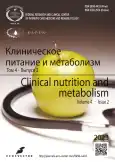Оценка частоты потребления различных групп молочных продуктов студентами Российского университета дружбы народов
- Авторы: Ханферьян Р.А.1, Радыш И.В.1, Семин Д.А.1, Гейко Е.Г.1, Коростелева М.М.1,2
-
Учреждения:
- Российский университет дружбы народов имени Патриса Лумумбы
- Федеральный исследовательский центр питания, биотехнологии и безопасности пищи
- Выпуск: Том 4, № 2 (2023)
- Страницы: 66-74
- Раздел: Оригинальные исследования
- URL: https://journals.rcsi.science/2658-4433/article/view/131155
- DOI: https://doi.org/10.17816/clinutr451252
- ID: 131155
Цитировать
Полный текст
Аннотация
Обоснование. Молоко и молочные продукты являются важным компонентом сбалансированного рациона питания. Дефицит молока и молочных продуктов способствует нарушению основных показателей здоровья различных возрастных групп населения.
Цель — анализ частоты потребления различных групп молочных продуктов студентами.
Материалы и методы. В поперечном исследовании приняли участие 388 студентов очной формы обучения медицинского института Российского университета дружбы народов имени Патриса Лумумбы: 185 участников мужского пола и 203 участника — женского пола, средний возраст (20,4±2,2) и (21,9±1,7) года соответственно. Антропометрические измерения выполняли по стандартной программе. Частоту потребления различных групп молочных продуктов изучали с помощью модифицированной анкеты частотного потребления продуктов.
Результаты. При анализе анкеты частотного потребления продуктов было установлено, что около 14% опрошенных за прошедший месяц не употребляли молоко, треть — не употребляли творог, 21% — натуральные кисломолочные продукты, и 16% — кисломолочные продукты с различными наполнителями. Сыры твёрдых сортов отсутствуют в рационе у 7% опрошенных, а рассольные сыры — у 20%. На ежедневной основе пьют молоко 24% анкетируемых, употребляют творог — 5%, кисломолочные продукты — 17% (9% — натуральные продукты и 8% — с наполнителями), твёрдый сыр — 18%. Кроме того, были выявлены гендерные различия в особенностях потребительских предпочтений: девушки реже употребляют сливки, сметану, мягкий сыр и молоко. Среди девушек распространённость лиц с избыточной массой тела была выше и составила 25% (50 студенток), тогда как среди юношей — 19% (35 студентов). Была выявлена обратная умеренная связь между ежедневным употреблением молока и массой тела, а также между употреблением молока и индексом массы тела (r=–0,61и r=–0,65 соответственно).
Заключение. Среди студентов было выявлено недостаточное потребление молока и молочных продуктов, отмечена взаимосвязь между частотой их потребления и некоторыми показателями физического развития.
Ключевые слова
Полный текст
Открыть статью на сайте журналаОб авторах
Роман Авакович Ханферьян
Российский университет дружбы народов имени Патриса Лумумбы
Автор, ответственный за переписку.
Email: khanfer1949@gmail.com
ORCID iD: 0000-0003-1178-7534
SPIN-код: 1091-8405
Scopus Author ID: 6506324595
ResearcherId: I-9371-2012
доктор медицинских наук, профессор, кафедра иммунологии и аллергологии Медицинского института
Россия, 117198 Москва, ул. Миклухо-Маклая, 6Иван Васильевич Радыш
Российский университет дружбы народов имени Патриса Лумумбы
Email: radysh-iv@rudn.ru
ORCID iD: 0000-0003-0939-6411
доктор медицинских наук, профессор, первый заместитель директора медицинского института РУДН по учебной работе, заведующий кафедрой управления сестринской деятельностью медицинского института
Россия, 117198 Москва, ул. Миклухо-Маклая, 6Дмитрий Алексеевич Семин
Российский университет дружбы народов имени Патриса Лумумбы
Email: semin-da@rudn.ru
ORCID iD: 0000-0002-0583-7315
ассистент кафедры управления сестринской деятельностью
Россия, 117198 Москва, ул. Миклухо-Маклая, 6Елена Геннадьевна Гейко
Российский университет дружбы народов имени Патриса Лумумбы
Email: geyko-eg@rudn.ru
ORCID iD: 0000-0002-4175-4867
SPIN-код: 1734-1940
ассистент кафедры сестринской деятельностью
Россия, 117198 Москва, ул. Миклухо-Маклая, 6Маргарита Михайловна Коростелева
Российский университет дружбы народов имени Патриса Лумумбы; Федеральный исследовательский центр питания, биотехнологии и безопасности пищи
Email: korostel@bk.ru
ORCID iD: 0000-0002-2279-648X
SPIN-код: 5276-9459
кандидат медицинских наук, доцент
Россия, 117198 Москва, ул. Миклухо-Маклая, 6; МоскваСписок литературы
- Vasconcelos Q.D.J.S., Bachur T.P.R., Aragão G.F. Whey protein supplementation and its potentially adverse effects on health: a systematic review // Appl Physiol Nutr Metab. 2021. Vol. 46, N 1. P. 27–33. doi: 10.1139/apnm-2020-0370
- McGovern C., Rifas-Shiman S.L., Switkowski K.M., et al. Association of cow’s milk intake in early childhood with adiposity and cardiometabolic risk in early adolescence // Am J Clin Nutr. 2022. Vol. 116, N 2. P. 561–571. doi: 10.1093/ajcn/nqac103
- Gao R., Rapin N., Elnajmi A.M., et al. Skim milk as a recovery beverage after exercise is superior to a sports drink for reducing next-day postprandial blood glucose and increasing postprandial fat oxidation // Nutr Res. 2020. Vol. 82. P. 58–66. doi: 10.1016/j.nutres.2020.08.007
- Feeney E.L., O’Sullivan A., Nugent A.P., et al. Patterns of dairy food intake, body composition and markers of metabolic health in Ireland: results from the National Adult Nutrition Survey // Nutrition & Diabetes. 2017. Vol. 7, N 2. P. e243. doi: 10.1038/nutd.2016.54
- Kiesswetter E., Stadelmaier J., Petropoulou M., et al. Effects of Dairy Intake on Markers of Cardiometabolic Health in Adults: A Systematic Review with Network Meta-Analysis // Advances in nutrition. 2023. Vol. 14, N 3. P. 438–450. doi: 10.1016/j.advnut.2023.03.004
- Матосян К.А., Оранская А.Н., Пустовалов Д.А., и др. Особенности качественного состава жировой ткани в организме в пубертатном и постпубертатном возрасте с учетом возраста, пола, уровня физической активности и характера питания // Вопросы питания. 2015. Т. 84, № 5. С. 88–94.
- Евстратова В.С., Раджабкадиев Р.М., Ханферьян Р.А. Структура потребления макронутриентов населением различных регионов Российской Федерации. Вопросы питания. 2018. Т. 87, № 2. С. 34–38.
- Кобелькова И.В., Коростелева М.М., Кобелькова М.С. Изменение пищевых привычек, уровня физической активности и их влияние на массу тела в период пандемии // Всероссийская междисциплинарная научно-практическая конференция «Социально-значимые и особо опасные инфекционные заболевания»; Октябрь 26–29, 2021; Сочи. Режим доступа: https://elibrary.ru/item.asp?id=47266798
- Тутельян В.А., Батурин А.К., Конь И.Я., и др. Распространенность ожирения и избыточной массы тела среди детского населения РФ: мультицентровое исследование // Педиатрия. Журнал имени Г.Н. Сперанского. 2014. Т. 93, № 5. С. 28–31.
- Aslam H., Ruusunen A., Berk M., et al. Unravelled facets of milk derived opioid peptides: a focus on gut physiology, fractures and obesity // International Journal of Food Sciences and Nutrition. 2020. Vol. 1, N 1. P. 36–49. doi: 10.1080/09637486.2019.1614540
- Foisy Sauvé M., Spahis S., Delvin E., Levy E. Glycomacropeptide: A Bioactive Milk Derivative to Alleviate Metabolic Syndrome Outcomes // Antioxidants & Redox Signaling. 2020. Vol. 34, N 3. P. 201–222. doi: 10.1089/ars.2019.7994
- Ogiwara M., Ota W., Mizushige T., Kanamoto R., Ohinata K. Enzymatic digest of whey protein and wheylin-1, a dipeptide released in the digest, increase insulin sensitivity in an Akt phosphorylation-dependent manner // Food Funct. 2018. Vol. 9, N 9. P. 4635–4641. doi: 10.1039/c8fo00919h.
Дополнительные файлы







